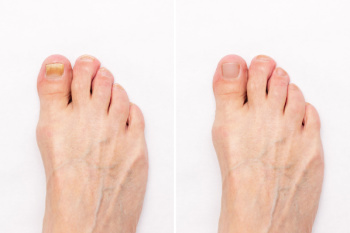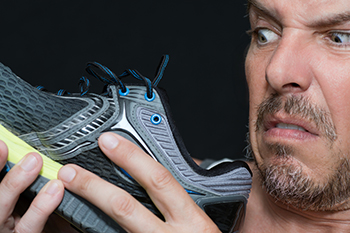
Toenail fungus, or onychomycosis, is a condition that primarily affects toenails. Symptoms of toenail fungus include discoloration, thickening, and separation of the affected toenail. It typically occurs when fungi infiltrate the nail bed, often spreading from adjacent skin infections, such as athlete’s foot, or through breaks or injuries in the nail itself. Risk factors include diabetes, circulatory issues, and immune system deficiencies, in addition to being over 60 years old, wearing poorly ventilated footwear, and working in humid environments. Athletes, especially runners, are also at a higher risk, due to toenail trauma and prolonged exposure to warm, moist conditions within their shoes. Prevention involves maintaining proper foot hygiene, wearing breathable footwear, promptly addressing nail abnormalities, and avoiding barefoot walking in public areas like changing rooms and showers where the fungal spread is more likely. Because eradicating toenail fungus can be a lengthy process, prompt attention is needed. If your toenails have been infected, it is suggested that you schedule an appointment with a chiropodist for an exam and treatment options.
Toenail fungus can be uncomfortable and unsightly. If you have diabetes or a compromised immune system, it may also be dangerous. To learn more about treatment options, please consult with one of the chiropodists from The Footcare Centre. Our chiropodists will assess your condition and provide you with quality foot and ankle treatment.
What Does Toenail Fungus Look Like?
A fungal infection of the toenail may cause the affected nail to become thickened, brittle, crumbly, and yellowish or brown in color. Sometimes the toenail may separate from the nail bed, become deformed, emit a foul odor, or cause pain or discomfort.
What Causes Toenail Fungus?
Toenail fungus is caused by a fungus that infects the nail bed. The fungus lives and thrives in warm and moist environments and is also contagious. Athlete’s foot, which is a fungal infection of the skin, may spread to the nails and cause toenail fungus.
What Treatments Are Available?
Potential treatments for toenail fungus may include oral antifungal medications, topical antifungal medications, such as medicated nail polishes that are applied directly to the affected nail, and laser therapy. Sometimes, a combination of treatments is prescribed.
If you have any questions, please feel free to contact our office located in . We offer the newest diagnostic and treatment technologies for all your foot care needs.





